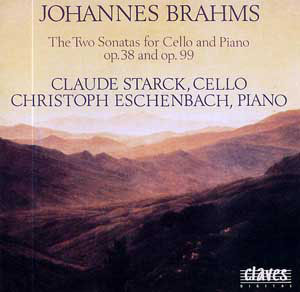|
Of all the major 19th century composers after Beethoven,
none achieved a greater contribution in chamber music than Brahms. And
the two cello sonatas are masterly examples of his genius in such music.
With a prolific composer such as Brahms it is all too
tempting to take things for granted, so comparisons between these two
pieces are usefully illuminating. For each work has its own particular
and distinctive personality, while using to the full the possibilities
of the partnership of cello and piano, and of the balances between strongly
identified themes.
These characteristics are particularly striking if comparisons
between the two opening movements are made. For example, in the E minor
Sonata, Opus 38, the composer chooses a broad Allegro non troppo, which
in this performance prompts Starck to produce a most satisfying and full
tone in the distinctive melodic arch of the principal theme (TRACK 1:
0.00). As the movement proceeds, he is prone to indulge the romantic expressiveness
of the music, slowing the tempo accordingly (TRACK 1: 7.55). In the Second
Sonata, Opus 99, the opening Allegro is presented quite differently, with
a Vivace intensification of tempo which therefore places an extra importance
on the nature of the rhythmic vitality (TRACK 4: 0.00). Here also the
artists respond positively to the challenge, and their reading of the
score is splendidly lively and vital.
Of course the comparisons between the two sonatas are
endlessly fascinating, and make one wonder whether Brahms responded to
the task of composing a second sonata by referring back to the first and
making the new work very different. With his more relaxed opening tempo
in Opus 38, Brahms dispenses with a conventional slow movement, and goes
further in opting for a three rather than a four-movement design. The
central movement, marked Allegretto quasi Menuetto, presents the performers
with some subtle challenges of interpretation, and their balancing, phrasing
and pacing of the music brings many insights (TRACK 2: 0.00). Perhaps
the contrasting trio (TRACK 2: 2.33) is somewhat relaxed, but this is
heard in the context of a performance with tempi which tend to be spacious,
a valid enough view.
In the Second Sonata, Opus 99, there is a true slow movement,
an Adagio affettuoso, which the artists play with rare sensitivity (TRACK
5: 2.00). The skilful combination of these artists is nowhere better captured
than in the resplendent finale of Opus 99 (TRACK 7: 0.00). At just over
four minutes this is not a big movement in terms of length, but it has
a magnificently powerful sweep, which Starck and Eschenbach communicate
to the full (TRACK 7: 0.00).
On CD the Brahms sonatas combine at less than an hour's
music, and many recordings offer an additional item or two. That is not
the case here, but the programme is certainly satisfying enough to stand
on its own. Claude Starck is an excellent cellist with a strong technique,
and he brings many insights, as well as combining most effectively with
his pianist, Christoph Eschenbach. We should remember that the latter
was a top class concert pianist before embarking upon his successful career
as a conductor. In these Brahms sonatas the piano part cannot be relegated
to the description 'accompaniment', since the concept is one of partnership
of equals. That equality is always found here, and the music gains from
it, aided by recording at once sensitive and atmospheric.
Terry Barfoot
|
CD Price: £ 11.50 Post-free Air Mail World-wide
- Download Price:
£ 7.11
Buy
CD:
Download all tracks:
FREE SOUND SAMPLES
(minimum 30 secs)
Sonata for Cello and Piano in E minor Op.38
Allegro
non troppo
Allegretto
quasi Menuetto
Allegro
Sonata for
Cello and Piano in F major Op.99
Allegro
Vivace
Adagio
affettuoso
Allegro
passionato
Allegro
molto
You require
QuickTime to listed to samples.
Get a free
QuickTime download here
|

